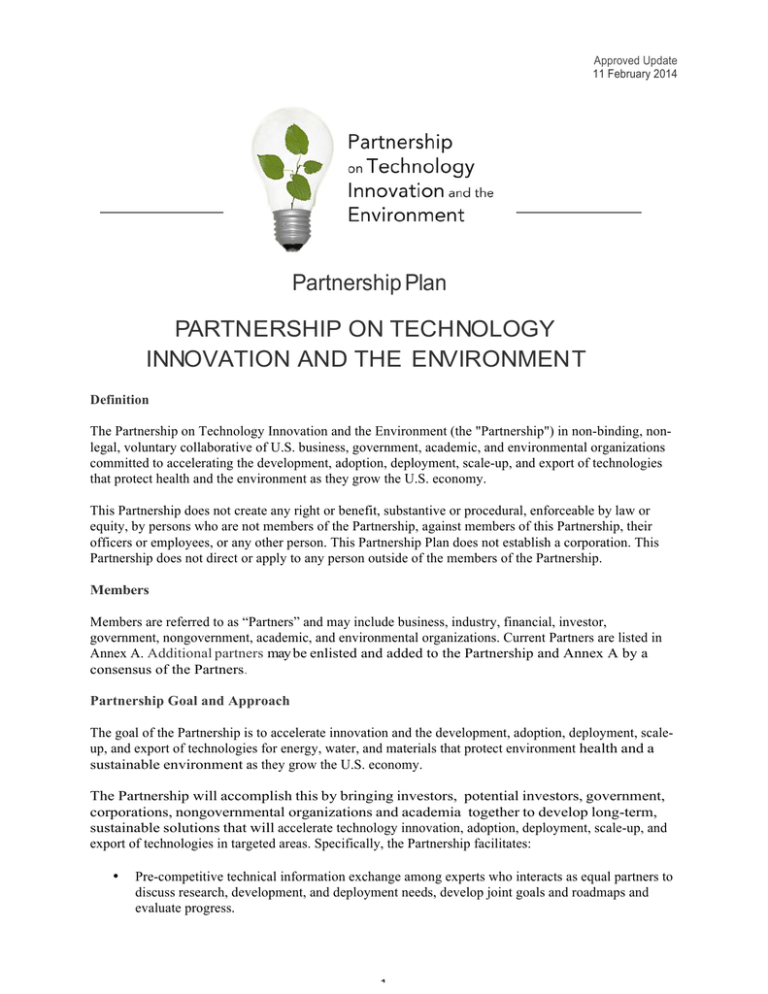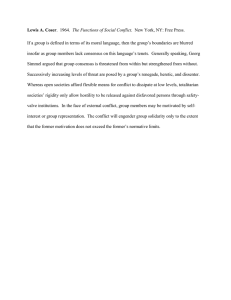Partnership Plan PARTNERSHIP ON TECHNOLOGY INNOVATION AND THE ENVIRONMENT
advertisement

Approved Update 11 February 2014 ! Partnership Plan PARTNERSHIP ON TECHNOLOGY INNOVATION AND THE ENVIRONMENT Definition The Partnership on Technology Innovation and the Environment (the "Partnership") in non-binding, nonlegal, voluntary collaborative of U.S. business, government, academic, and environmental organizations committed to accelerating the development, adoption, deployment, scale-up, and export of technologies that protect health and the environment as they grow the U.S. economy. This Partnership does not create any right or benefit, substantive or procedural, enforceable by law or equity, by persons who are not members of the Partnership, against members of this Partnership, their officers or employees, or any other person. This Partnership Plan does not establish a corporation. This Partnership does not direct or apply to any person outside of the members of the Partnership. Members Members are referred to as “Partners” and may include business, industry, financial, investor, government, nongovernment, academic, and environmental organizations. Current Partners are listed in Annex A. Additional partners may be enlisted and added to the Partnership and Annex A by a consensus of the Partners.! Partnership Goal and Approach The goal of the Partnership is to accelerate innovation and the development, adoption, deployment, scaleup, and export of technologies for energy, water, and materials that protect environment health and a sustainable environment as they grow the U.S. economy. The Partnership will accomplish this by bringing investors, potential investors, government, corporations, nongovernmental organizations and academia together to develop long-term, sustainable solutions that will accelerate technology innovation, adoption, deployment, scale-up, and export of technologies in targeted areas. Specifically, the Partnership facilitates: • ! Pre-competitive technical information exchange among experts who interacts as equal partners to discuss research, development, and deployment needs, develop joint goals and roadmaps and evaluate progress. 1! Approved Update 11 February 2014 ! • Analyses and evaluations of approaches to address institutional, policy, and financial barriers that inhibit innovation, adoption, deployment, scale-up, and export of environment-friendly technologies. • Development of consensus recommendations and actionable plans to develop markets. The Partnership itself does not conduct or fund research, development, demonstration; each partner makes its own decisions regarding the funding and management of its projects, whether individually or jointly with other partners and/or non-partners. The Partnership's work products may include analyses, roadmaps and consensus recommendations made public through a variety of media. Rationale The most efficient way to speed innovation and the development and adoption of environmentally friendly technologies is to promote collaboration and seek broad agreement among those stakeholders whose cooperation can catalyze and sustain the growth and long-term success of a robust market for environmental technologies. A collaborative program to develop consensus recommendations on how to stimulate innovation and promote key technologies or technology sectors will assure an efficient and more comprehensive and durable consideration of the issues. By bringing together technical, business, investment, and policy experts in a common area of expertise and by providing a framework for frequent and regular interaction, the Partnership will: • • Accelerate technical innovation, development, and deployment progress: peers in the technical, business, investment and policy communities discuss pre-competitive, technology-specific research, development, and deployment needs and challenges, identify possible solutions and evaluate progress toward jointly-developed goals. Help ensure that publicly- and privately-funded technology research, development, demonstration, evaluation and implementation to deliver high-value results to effectively overcome barriers to the successful development, adoption, deployment, scale-up, and export of innovative environmentally beneficial technologies. Topics Partners periodically will review and define technology focus areas and topics on which to focus. Prior and current topics are listed in Annex B. Additional topics may be enlisted and added to Annex B by a consensus of the Partners.! Operating Principles • • • • ! Partners operate as equals in the Partnership. Partners make a strong commitment to participate in the Partnership at all levels; this includes providing top technical expertise with the capacity to substantively contribute to technical team operation, as well as engaging at the management and senior management levels to facilitate Partnership success. Partners must comply with all applicable laws and regulations, including U.S. anti-trust and competition laws; further, partners conduct activities in a way that avoids any appearance of anticompetitive behavior, even though no violation of laws has occurred. Each Partner makes its own decisions regarding its own funding of projects and programs, 2! Approved Update 11 February 2014 ! • • • according to its own internal policies, requirements, and/or guidelines; similarly, each partner directs and manages its own projects and programs according to its own internal policies, procedures, and requirements. No proprietary government or company confidential business information is introduced in the Partnership process. Proprietary information is defined as information that an affected business claims to be confidential and is not otherwise available to the public. The Partnership is a voluntary, non-binding, and non-legal collaboration. Partners may choose to discontinue their participation at any time; should an organization choose to leave, however, it cannot resume participation without consensus of the current partners. Partners abide by and conduct activities in accordance with this Partnership Plan. Decision Making and Work Product Approval • • • Partners use a consensus process to make decisions about technical direction and Partnership targets, membership (new partners}, and other key matters that affect the Partnership. Partners have the option to abstain from participating in the consensus process for any given decision. The Partnerships members approve the Partnership Plan and any substantive changes to the Plan by consensus. The Plan may be revised by a consensus of the Partnership without resigning. The partners also approve Partnership plans and roadmaps, goals, targets, and recommendations, as well as any changes to these. Decisions are made by consensus. Any technical or project teams developed under the auspices of the Partnership make decisions by consensus. Commencement/Duration/Modification/Termination This Partnership takes effect upon signature of the members. A partner may terminate its participation in this Partnership at any time by providing written notice to the other partners, at least 90 days in advance of desired termination date. Prohibition on Obligation of Federal Funds As required by the Anti-deficiency Act, 31U.S.C.1341and1342, all commitments made by Federal government partners are subject to the availability of appropriated funds. Nothing in this Partnership, in and of itself, obligates the Federal government to expend appropriations or to enter into any contract, assistance agreement, interagency agreement, or incur other financial obligations that would be inconsistent with a Federal government organization's budget priorities. The Partnership and its members agree not to submit a claim for compensation for service rendered to Federal government partners in connection with any activities it carries out in the furtherance of this Partnership. This Partnership does not exempt members from Federal government policies governing competition for assistance agreements. Any transaction involving reimbursement or contributions of funds between partners in this Partnership will be handled in accordance with applicable laws, regulations and procedures under separate written agreements. Use of Official Seals of Federal Government Members of the Partnership The official seals and identifiers of Federal government agency members only may be used for official Federal government purposes and may not be used to promote commercial products or services. Use of official Federal government seals or identifiers on Partnership documents, or in Federal government partner own written material/web content (“partners”) relating to the activities carried out under the Partnership may generally meet the official purpose test. Additionally, a partner may be allowed to display the seal of Federal government partner on brochures and other materials relating to joint activities, for purposes of identifying the Federal government partner. However, any product, including those ! 3! Approved Update 11 February 2014 ! products of the other partners, that use the seal or identifier of a Federal government agency according to its internal procedures. Use of Trademarks, Logos, Identifiers, or Emblems of Non-Government, Academia, and Private Sector Organizations Use of trademarks, logos, identifiers, or emblems of non-government, academia, or private sector organizations on Partnership documents, in a Partner’s own written material/web content relating to the activities carried out under the Partnership require advance approval from the individual organization(s) and the consensus of the Partnership. Use of the Partnership logo in a Partner’s own written material/web content requires advance consensus of the Partnership. Endorsements Nothing in this Partnership Plan constitutes an endorsement by any other Partner of the products, service and/or fundraising activities of the others. The Partnership and individual partners agree not to make statements to the public at workshops and meetings, in promotional literature, on web sites or through any other media that imply Federal government endorsement of any service or product offered by the partners or non-members of the Partnership. In addition, the Partnership will not make statements that imply Federal government support of a partner's effort to raise public or private funds. Any statements or promotional materials prepared by the Partnership that describe Federal government agencies' agreement to this Partnership Plan and participation in the Partnership must be approved by the member agencies. ! ! 4! Approved Update 11 February 2014 ! ! ! ! Agreed to: ! ! ! Duke University, Nicholas Institute for Environmental Policy Solutions ! ! ! ! ! Date Additional signatories here: ! ! 5! Approved Update 11 February 2014 ! ANNEX A PARTNERS AND AFFILIATES PARTNERS Center for Environmental Policy, American University Environmental Defense Fund The Initiative for Global Environmental Leadership, The Wharton School, University of Pennsylvania The H. John Heinz III Center for Science, Economics and the Environment (dissolved December 31, 2013) Nicholas Institute for Environmental Policy Solutions, Duke University United States Environmental Protection Agency United States Department of Commerce, International Trade Administration* United States Department of Energy* World Business Council for Sustainable Development AFFILIATES United States Army, Office of the Deputy Assistant Secretary (Energy and Sustainability) !!!!!!!!!!!!!!!!!!!!!!!!!!!!!!!!!!!!!!!!!!!!!!!!!!!!!!!!!!!!! * ! Proposed.! 6! Approved Update 11 February 2014 ! ANNEX B! FOCUS TOPIC AREAS JANUARY– JUNE 2013 Bio-digesters and bio-gas technology Fence line air quality monitoring Auto supply chain innovations DECEMBER 2013 – JUNE 2014 Financing for More Efficient Drinking Water Systems Challenging Nutrients: Technology Innovation for Better Water Quality Leveraging Financing Models for Innovation in Wastewater Treatment ! 7!


